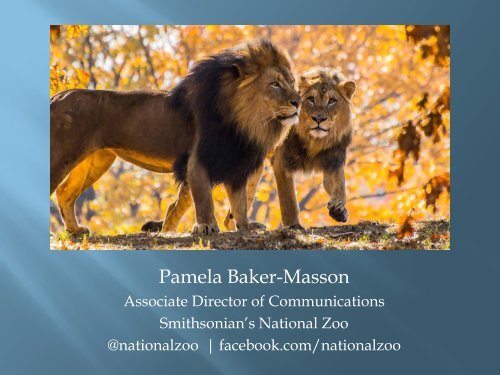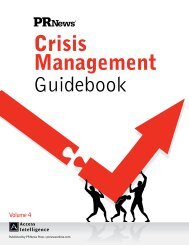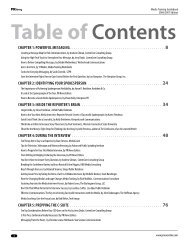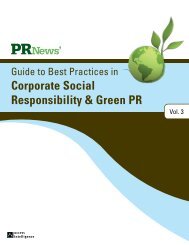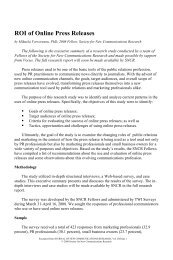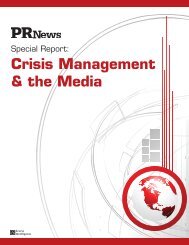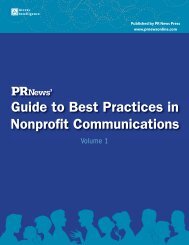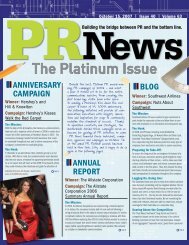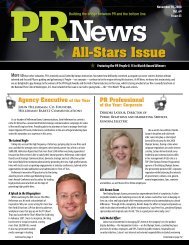Pamela Baker-Masson - PR News
Pamela Baker-Masson - PR News
Pamela Baker-Masson - PR News
Create successful ePaper yourself
Turn your PDF publications into a flip-book with our unique Google optimized e-Paper software.
<strong>Pamela</strong> <strong>Baker</strong>-<strong>Masson</strong><br />
Associate Director of Communications<br />
Smithsonian’s National Zoo<br />
@nationalzoo | facebook.com/nationalzoo
“I’m on Twitter and I<br />
follow it a bit, but I don’t<br />
think I’ve ever gotten a<br />
pitch through it or even a<br />
story idea.” – Washington<br />
Post Columnist<br />
“Twitter is one of the most valuable sources for leads/tips that<br />
I’ve come across in journalism.” – Washingtonian<br />
“I think tweet-pitching is in its<br />
infancy.” – Washington Post<br />
Reporter<br />
“So, I have a dark secret. I am awful,<br />
awful, awful at Twitter.” – N<strong>PR</strong>
• A new version of the AP Daybook<br />
• It’s viewed as a news source<br />
• The character limit makes it a tip sheet
• “I rely on it daily as a news source and particularly to send<br />
tips and tweets on to other writers to follow-up.” – Magazine<br />
editor<br />
• “I limit the number of Twitter feeds that I follow directly to<br />
official sources from the agencies that I cover and some select<br />
news media. What I get are not so much story pitches as alerts<br />
to news I may cover.” – Bloomberg<br />
• “I see some breaking news items appear first on Twitter as a<br />
lead that we then pursue for a story with phone calls, e-mails,<br />
etc. This happens more often with public safety stories, such as<br />
a school bus crash or police news.” – AP.<br />
• “During the campaign, the Twitter feeds of both presidential<br />
campaign organizations made announcements, as did the<br />
White House, via Twitter that resulted in stories.” –<br />
Bloomberg<br />
Best examples: Prince George County police; the Obama for America<br />
organization; JFK Presidential Library (“on this date” history tweets.)
Panda artificial insemination (#PandaAI)
1. One lie and you’re<br />
sunk.<br />
2. Journalists don’t want<br />
random facts or old<br />
information.<br />
“Most of the tweets I see are<br />
pretty random factoids about<br />
things that have already<br />
happened.” – Washington<br />
Post
3. Media professionals will “unfollow” you if you:<br />
• Tweet only information perceived as unhelpful. If you are<br />
tweeting both to a general audience and media, must strike<br />
the right balance between breaking news, helpful tips, and<br />
general information.<br />
• Be prudent about the volume of your tweets.<br />
• Incorrect use of Twitter. Understand how to use a hashtag<br />
and tinyurls. It will appear obvious to all if you don’t use<br />
Twitter lingo.<br />
• Twitter is NOT the best place to offer<br />
an exclusive!<br />
“I would rather not have a first-time<br />
introduction for a pitch on Twitter. I am more<br />
receptive to hearing from <strong>PR</strong> folks on Twitter<br />
who I already know.” - AP<br />
• Better to PITCH via email or phone
• A crisis “unfolds”<br />
• Use Twitter to tell the story as it unfolds<br />
• Use Twitter to tell all pieces of the story<br />
Soyono: Preparing the media for bad news
1. Establish a relationship first with the journalist. Consider using<br />
a personal Twitter account rather than an organizational<br />
account.<br />
2. Use your organization’s account to follow all reporters and<br />
publications that have written stories about you.<br />
3. Your tweets are public. One or more reporters will read what<br />
you tweet directly to one outlet.<br />
4. Give credit where credit is due. If you retweet a story about<br />
your organization, give the credit to the journalist.<br />
5. Provide an experience.


